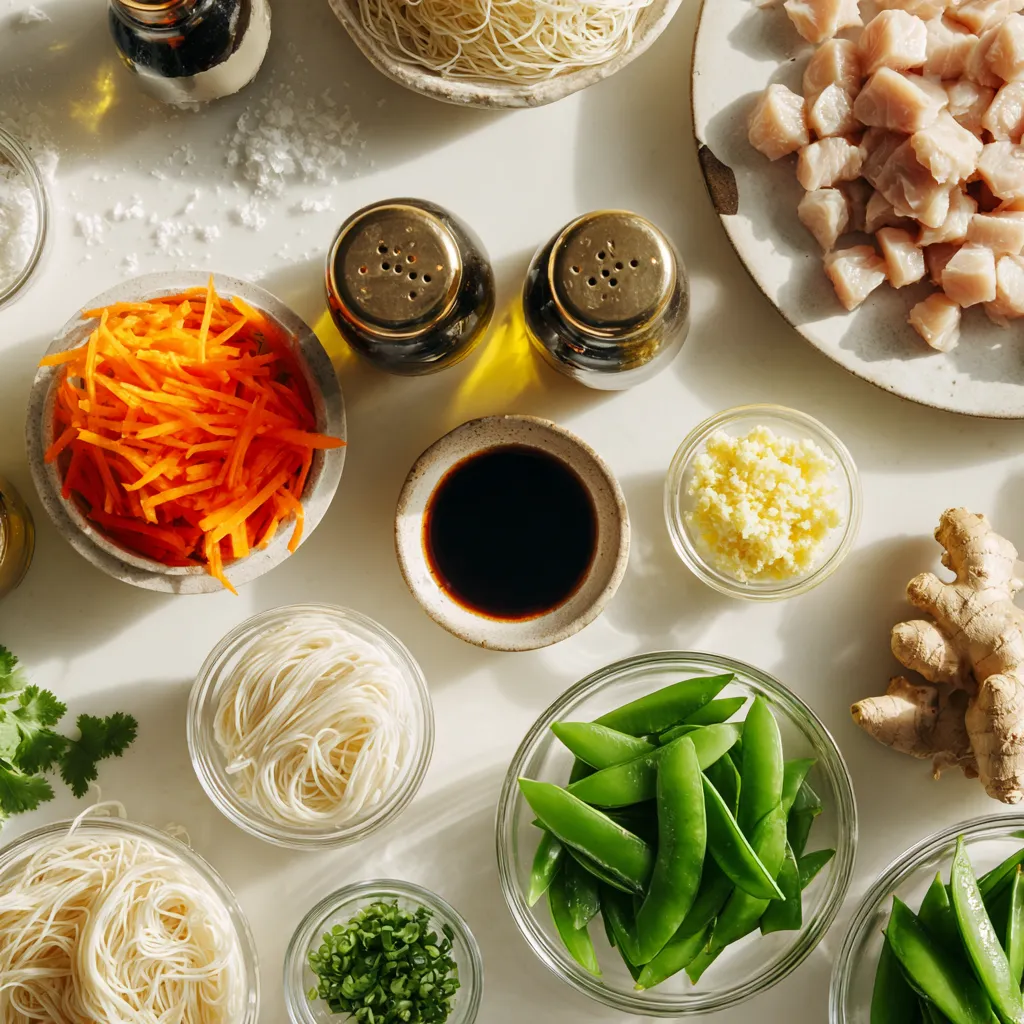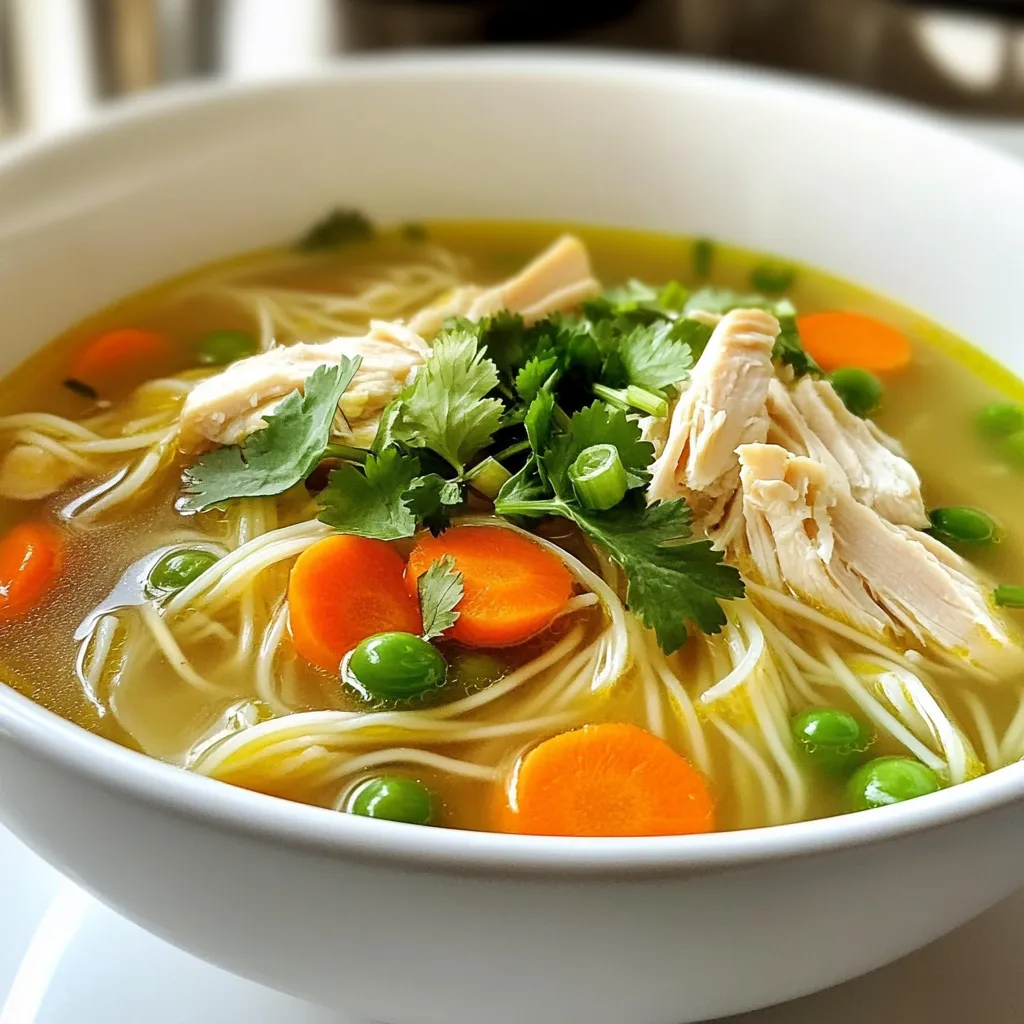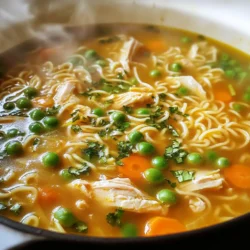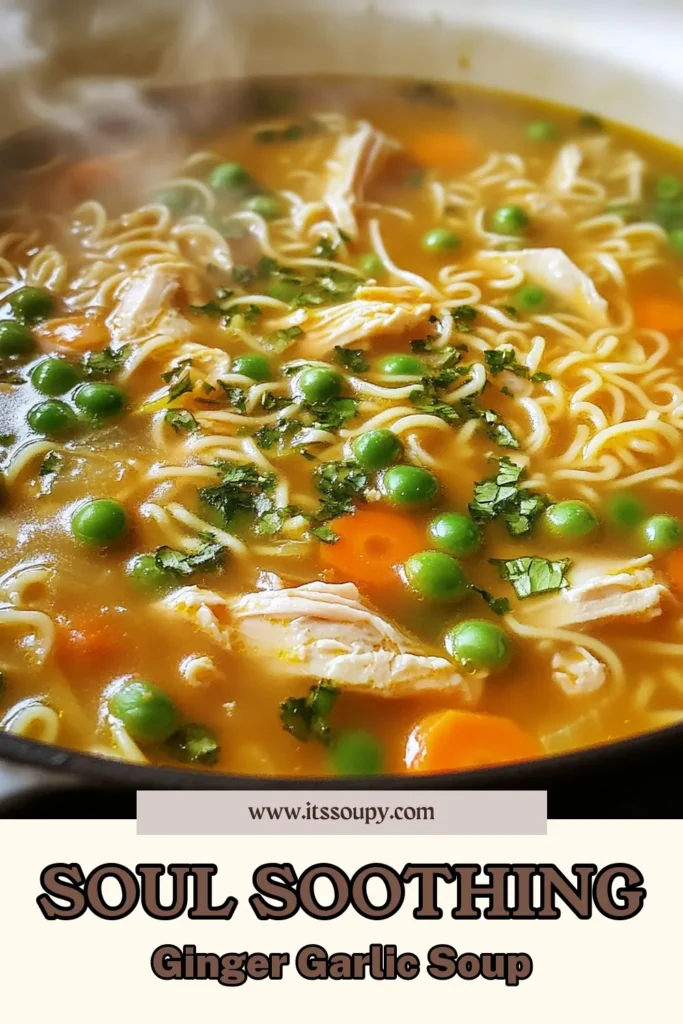Do you crave a warm bowl of Ginger Garlic Chicken Noodle Soup? This guide will show you how to boost the flavor and make it your own! I’ll share a detailed ingredient list, helpful substitutions, and nutritional facts to get started. You’ll also find step-by-step instructions, tips for improvement, and different variations to try. Let’s dive into this comforting dish that warms both your body and soul!
Why I Love This Recipe
- Comforting Flavor: This soup combines the warmth of ginger and garlic, creating a cozy dish perfect for any day.
- Quick and Easy: With a total time of just 30 minutes, this recipe is ideal for busy weeknights.
- Nutrient-Rich: Packed with vegetables and protein, this soup is not only delicious but also healthy.
- Customizable: Easily adjust the ingredients based on what you have on hand or your dietary preferences.
Ingredients
Detailed ingredient list
To make Ginger Garlic Chicken Noodle Soup, gather these fresh ingredients:
- 2 chicken breasts, boneless and skinless, diced
- 1 tablespoon fresh ginger, grated
- 4 cloves garlic, minced
- 4 cups chicken broth
- 2 cups water
- 2 carrots, sliced
- 1 cup snap peas, trimmed
- 5 oz rice noodles
- 2 tablespoons soy sauce (or tamari for gluten-free)
- 1 tablespoon sesame oil
- 1 tablespoon vegetable oil
- 2 green onions, chopped
- Fresh cilantro, for garnish (optional)
- Salt and pepper to taste
Ingredient substitutions
You can swap some ingredients based on what you have:
- Chicken can be replaced with tofu for a vegetarian option.
- Use vegetable broth instead of chicken broth for a lighter taste.
- If you don’t have rice noodles, try egg noodles or whole wheat noodles.
- For a gluten-free version, ensure the soy sauce is tamari.
- Snap peas can be replaced with green beans or broccoli.
Nutritional facts
This soup is not just tasty; it’s also healthy! Here are some key nutrition facts per serving:
- Calories: 320
- Protein: 30g
- Fat: 10g
- Carbohydrates: 30g
- Fiber: 3g
- Sodium: 600mg
This soup provides a good balance of protein, carbs, and healthy fats. It’s a great way to warm up and nourish your body!

Step-by-Step Instructions
Preparation of ingredients
Start by gathering all your ingredients. This makes cooking smooth and fun.
- 2 chicken breasts (diced)
- 1 tablespoon fresh ginger (grated)
- 4 cloves garlic (minced)
- 4 cups chicken broth
- 2 cups water
- 2 carrots (sliced)
- 1 cup snap peas (trimmed)
- 5 oz rice noodles
- 2 tablespoons soy sauce
- 1 tablespoon sesame oil
- 1 tablespoon vegetable oil
- 2 green onions (chopped)
- Fresh cilantro (optional)
- Salt and pepper
Make sure to wash your vegetables. Clean hands and tools keep everything safe.
Cooking the soup base
Next, heat the vegetable oil in a large pot over medium heat. Add the grated ginger and minced garlic. Sauté for 1-2 minutes until they smell great. This step builds a strong flavor base.
Now, add the diced chicken to the pot. Season with salt and pepper. Cook until the chicken is brown on all sides. This adds depth to the soup.
Pour in the chicken broth and water, stirring to mix well. Bring the mixture to a boil. When it starts bubbling, lower the heat. Add the sliced carrots and snap peas. Let it simmer for about 10 minutes. This helps the veggies become tender.
Adding noodles and final touches
After simmering, it’s time to add the rice noodles. Cook them according to the package instructions, usually around 4-5 minutes. Stir them gently into the soup.
Once the noodles are cooked, add soy sauce and sesame oil. Taste and adjust the seasoning with more salt and pepper if needed.
Finally, turn off the heat. Serve the soup hot in bowls. Top with chopped green onions and fresh cilantro, if you like. Enjoy the comforting flavors of your ginger garlic chicken noodle soup!
Tips & Tricks
How to enhance flavor
To boost the flavor of your soup, use fresh ginger and garlic. They add warmth and depth. I like to sauté them first in oil. This step wakes up their flavors. You can also add a splash of lime juice before serving. It brightens the dish. Consider adding a pinch of red pepper flakes for heat. This gives a nice kick. Lastly, fresh herbs like cilantro or basil add a burst of freshness.
Best practices for cooking chicken
When cooking chicken, cut it into small, even pieces. This helps it cook fast and stay juicy. Season with salt and pepper before adding it to the pot. Brown the chicken well before adding liquids. This step seals in flavor. Remember to cook it fully, but don’t overdo it. Overcooked chicken can become dry. To check if it’s done, use a meat thermometer. The safe temperature is 165°F.
Storing leftovers properly
Store leftover soup in an airtight container. It keeps the flavors fresh. Let the soup cool before sealing it. You can keep it in the fridge for up to three days. If you want to store it longer, consider freezing it. Pour the cooled soup into freezer-safe bags. Remove excess air and seal tightly. It can last up to three months in the freezer. To reheat, just warm it on the stove or in the microwave.
Pro Tips
- Use Fresh Ingredients: Fresh ginger and garlic will provide the best flavor for your soup. Avoid pre-minced or powdered versions for maximum aroma and taste.
- Customize Your Veggies: Feel free to add other vegetables like bell peppers, mushrooms, or spinach to enhance the nutritional value and flavor profile of your soup.
- Perfectly Cooked Noodles: To prevent overcooked noodles, add them to the soup only when you’re ready to serve. This helps maintain their texture.
- Serving Suggestions: Serve your soup with a squeeze of lime or lemon juice for an extra zing, and top it off with crushed red pepper flakes for a spicy kick.

Variations
Vegetarian option
You can make a tasty vegetarian version. Replace chicken with tofu or tempeh. For protein, use 1 cup of cubed tofu. Cook it until golden brown before adding broth. This gives the soup a nice texture. You can also add more veggies like mushrooms or bell peppers for extra flavor.
Adding different vegetables
Feel free to mix in your favorite veggies. Broccoli, spinach, or bok choy work great. Just chop them up and add them when you add the carrots and snap peas. This adds color and boosts nutrition. You can also experiment with other seasonal vegetables for a fresh twist.
Gluten-free adjustments
For a gluten-free version, use tamari instead of soy sauce. Choose rice noodles, as they are naturally gluten-free. Check your chicken broth for gluten-free labeling. You can also add gluten-free miso paste for a deeper flavor. This way, you can enjoy the soup without worry.
Storage Info
Freezing the soup
You can freeze Ginger Garlic Chicken Noodle Soup easily. First, let the soup cool completely. Pour it into freezer-safe containers or bags. Leave some space at the top, as the soup will expand when frozen. Seal the containers tightly. The soup stays good for about 2 to 3 months in the freezer. When you’re ready to eat, thaw it in the fridge overnight before reheating.
Reheating instructions
Reheating the soup is simple. Pour the thawed soup into a pot. Heat it over medium heat until it is hot. Stir it often to prevent sticking. You can also microwave it in a bowl. Heat it in short bursts, stirring in between, until warm. If the soup seems thick, add a splash of water or broth to loosen it.
Shelf life of the dish
The soup lasts about 3 to 4 days in the fridge. Store it in an airtight container to keep it fresh. If you notice any changes in color or smell, it’s best to throw it out. Always check for freshness before eating. Enjoy your soup while it’s still tasty!
FAQs
Can I use other types of noodles?
Yes, you can use other noodles. Try egg noodles or udon noodles for a twist. Rice noodles are light, but these others add a nice bite. Cook them according to the package for best results.
How can I make it spicier?
Add fresh chili peppers or red pepper flakes. You can also use chili oil for a deep kick. Start with a little, then add more to reach your spice level. Don’t forget, spice builds as it cooks!
What can I substitute for chicken?
To make it vegetarian, use tofu or tempeh. You can also try mushrooms for a meaty texture. If you want a seafood twist, shrimp works well too. Adjust cooking times as needed based on your choice.
How long does it take to cook the chicken?
Cooking the chicken takes about 6-8 minutes. Make sure it’s browned on all sides. Always check that the internal temperature is 165°F for safety. The chicken will finish cooking in the broth, adding flavor to the soup.
This blog post shared how to make a tasty soup from scratch. We covered ingredients, cooking steps, and tips to boost flavor. You learned to customize the recipe and store any leftovers. Whether you seek a vegetarian take or need gluten-free options, this guide has you covered. Keep these tips in mind for a delightful meal anytime. Enjoy your cooking journey and savor each bow

Ginger Garlic Chicken Noodle Soup
Ingredients
- 2 breasts chicken, boneless and skinless, diced
- 1 tablespoon fresh ginger, grated
- 4 cloves garlic, minced
- 4 cups chicken broth
- 2 cups water
- 2 carrots sliced
- 1 cup snap peas, trimmed
- 5 oz rice noodles
- 2 tablespoons soy sauce
- 1 tablespoon sesame oil
- 1 tablespoon vegetable oil
- 2 green onions chopped
- fresh cilantro, for garnish (optional)
- salt and pepper to taste
Instructions
- In a large pot, heat the vegetable oil over medium heat. Add the grated ginger and minced garlic, sautéing for about 1-2 minutes until fragrant.
- Add the diced chicken breasts to the pot. Season with salt and pepper, cooking until the chicken is browned on all sides.
- Pour in the chicken broth and water, stirring to combine. Bring the mixture to a boil.
- Once boiling, reduce the heat and add sliced carrots and snap peas. Let it simmer for about 10 minutes, allowing the vegetables to soften.
- Stir in the rice noodles and cook according to package instructions, typically around 4-5 minutes.
- Add soy sauce and sesame oil, adjusting the seasoning with more salt and pepper if needed.
- Once noodles are cooked, remove from heat. Serve immediately in bowls, garnished with chopped green onions and fresh cilantro if desired.


